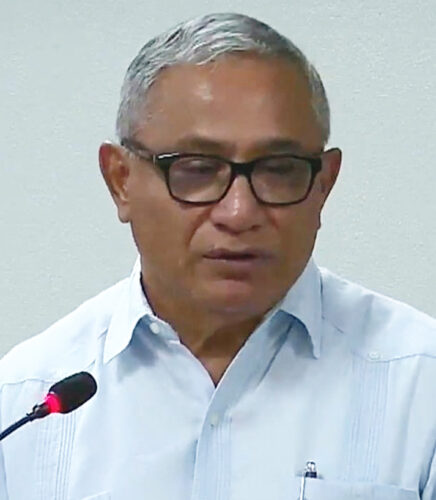Hon. Jose Mai, Minister of Agriculture
ASR-BSI reports 2024-25 sugar cane crop the worst ever
by William Ysaguirre (Freelance Writer)
TOWER HILL, ORANGE WALK, Fri. June 27, 2025
The 2024-25 sugar cane harvest was one of the worst ever, with an estimated 79,000 tonnes of sugar produced out of only 884,000 tonnes of sugar cane that was delivered and milled. This was outlined to the media by Belize Sugar Industries Ltd financial director, Shawn Chavarria via a ZOOM virtual press conference on Friday morning, June 27. It represents a huge loss of earnings for both the mill and farmers, he said.

Shawn Chavarria, BSI finance director
After rain delayed the start of the crop by 2 weeks to December 27, heavy rains forced another stoppage, when low sugar content and high mud content in the sugar cane made it financially unprofitable to continue. The industry experts agreed to stop and let the cane ripen to improve sugar content. When milling resumed, the cane quality was still poor, as some 60,000 acres had been affected by the Fusarium fungus, and Chavarria reported that at the end of the crop, the average Tonnes Cane to Tonne Sugar ratio (TCTS) was still poor: 11.2 TCTS, when in a good year the average TCTS was about 9, with some truck loads testing a TCTS of 8, but not this year.
The farmers are paid for the sugar content in their cane, which this year only yielded about 79,000 tonnes of sugar, even lower than the previous record low in 2008, when the factory produced just over 79,000 tonnes of sugar. It’s far less than last year when the factory produced 104,366 tonnes of sugar from 1,043,952 tonnes of sugar cane milled, and farmers received a record cane payment of $90.23 per tonne of cane. This year was disappointingly low even by comparison with the 2020 crop, when the industry was recovering from the effects of the 2019 drought; in 2020 the factory milled 893,662 metric tonnes of cane, but produced almost 88,000 tonnes of sugar, a TCTS ratio of 10.1.
This year, the industry will earn about $110 million, which is $53 million less than the $163.5 million earned last year. The cane payment to farmers is expected to be $65.00/tonne of cane, which is $25 less than last year. Chavarria estimates that very little stand-over cane was left that the farmers could not deliver, perhaps about 20,000 tonnes of cane, as the total cane yield was drastically lower than last year, about 16 percent less.
The factory’s lost time was also much higher, for although the factory only lost 120 hours due to factory maintenance down time, the factory lost 500 hours grinding time due to the weather, and it lost another 160 hours when the factory was out of cane because the farmers were unable to keep up deliveries to keep the mill supplied with cane. This meant that the mill had to grind much slower than the optimal target of 6,800 – 7,000 tonnes of cane per day, and less cane milled also meant less bagasse going to the BELCOGEN furnaces, so less electricity produced to be sold to the grid, Chavarria lamented, as this meant further financial losses for BSI and for the farmers. This was far less than the company’s optimal target of 1.3 million tonnes of cane milled per crop.
The main reason for the lower yield was the Fusarium fungus, admitted BSI’s cane farmer relations manager Olivia Carballo-Avilez, and the company and the Sugar Industry Research and Development Institute (S.I.R.D.I.) hope to help farmers fight the Fusarium scourge by replanting their cane fields with disease resistant varieties. The company introduced 11 new varieties to farmers in October 2022, and the farmers have received record cane payments in the last 2 crops, but did not invest in replanting their fields. The fusarium is a symptom of older cane, Avilez said—“the plantations that really need to be replanted, and the transformation really needs to happen.”
It is customary practice in the industry, that after harvesting, the farmers allow the sugar cane to sprout from the roots still in the ground for 3 to up to 5 or 6 years; but this older cane is weaker and more susceptible to diseases, Chavarria pointed out. “The fields need to be renovated urgently in order for it to be a healthier cane, with new varieties that are more resistant to some of these pests and diseases,” Chavarria declared.
Minister of Agriculture and Food Security, Hon. Jose Mai is adamant about the measures that need to be taken to eradicate Fusarium from the cane fields—a scorched earth policy in which the sugar cane is burnt before harvest, and a second burning of the cane trash left in the fields, in the hopes of sterilizing the fields and killing the Fusarium by heat. He has also proposed that the industry invest in acquiring new sugar cane germ plasm to breed new resistant varieties. The current situation cannot be allowed to continue, Mai said, or the farmers could find their production reduced even further next year to 600,000 tonnes of cane, which would be half the optimal 1.3 million tonnes target.

Hon John Briceño, Prime Minister
“Our farmers will take home $31 million less than they took home last year,” Prime Minister Hon. John Briceño revealed, when he addressed the House of Representatives on Friday. Fusarium seems to be signaling a death knell for the industry, unless drastic steps are taken to eliminate Fusarium, as the S.I.R.D.I. is predicting that production could fall below 700,000 tonnes of sugar cane next crop.
“We must therefore urgently make concrete and targeted interventions if we are to avoid this kind of devastation in the sugar industry,” Briceño affirmed. “$500,000 has already been identified by the Ministry of Agriculture which will be allocated to a pilot initiative to start ridding these fields of the disease. Last November, researchers at S.I.R.D.I. moved quickly to identify a possible treatment option, and earlier this year began testing this technology on 2 un-farmed research plots. The results of this treatment, at least in the initiative stages, looks very promising. We’ve also met with ASR/BSI and they have brought in their soil scientist from Florida, where they have had a lot of success in dealing with it, and they too have also a treatment for this fungus … They will be working with the Ministry of Agriculture, because this is a joint effort to see what would be the best way to halt the spread of this disease and cure the fields that have been infected,” he said.
Not all may be happy with the solutions that Mai proposes, as he also suggested that the local retail price for sugar needs to be increased to be on par with the price of sugar in neighboring countries. He recommends that farmers be allowed to profit more from the price of local sugar, as the current, subsidized price structure to protect Belizean consumers also creates a price gradient that favors contraband (which may also lead to a shortage of supply for the local market). An unscrupulous wholesale buyer can earn a 200 percent profit simply by smuggling high-quality, Belizean white sugar across the border, where the demand is high, and the contraband sugar will fetch 3 times the price paid in Belize.

